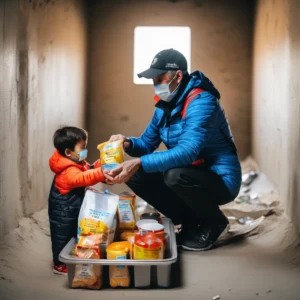Kid-Friendly Emergency Food Storage: The Ultimate Guide for Parents
Disasters strike without warning, and when they do, your family’s food supply could mean the difference between calm and chaos. But here’s the catch—children have unique dietary needs and tastes that aren’t always compatible with traditional emergency rations. If your emergency food storage isn’t tailored to your kids, mealtime during a crisis could become a battle.

Understanding Children’s Nutritional Needs in Emergencies
During emergencies, children require a balanced diet to keep them healthy and energized. Their growing bodies need a steady supply of proteins, carbohydrates, and healthy fats, along with essential vitamins and minerals. Without these nutrients, their immune systems can weaken, and they may struggle with energy and focus.
Caloric intake must also be a priority. Unlike adults, children burn through energy quickly and need frequent meals and snacks. A diet lacking in variety can lead to food fatigue, where kids refuse to eat unfamiliar or repetitive meals. Hydration is another critical factor—clean water is not just for drinking but also for food preparation and digestion.
Factors to Consider When Choosing Kid-Friendly Emergency Foods
Not all emergency foods are created equal. When selecting items for your family’s storage, consider shelf life and packaging durability. Foods with a longer shelf life and sturdy packaging are less likely to spoil or become contaminated.
Ease of preparation is another major factor. In stressful situations, meals that require minimal or no cooking can be lifesavers. Moreover, choosing foods with familiar flavors will help ease emotional distress in children by keeping their diets as normal as possible. If your child has allergies or dietary restrictions, ensuring safe food options is non-negotiable.

Recommended Shelf-Stable Food Categories
Canned Goods
Canned soups and stews provide balanced meals with protein and carbohydrates. Fruits stored in juice or light syrup offer a natural source of vitamins, while canned vegetables and beans supply necessary fiber and minerals.
Freeze-Dried and Dehydrated Foods
These lightweight, long-lasting options are excellent for emergency kits. Freeze-dried meals designed for camping or survival scenarios are easy to prepare. Dried fruits and vegetables make great snacks, and powdered dairy options like milk and yogurt bites ensure kids get their necessary calcium intake.
High-Protein Options
Protein is key for physical and mental development. Jerky, canned tuna, and canned salmon are excellent sources. Younger children may prefer nut butter or seed butter, which are both nutrient-dense and easy to eat. Child-friendly protein bars can serve as quick, satisfying snacks.
No- or Low-Cook Staples
Ready-to-eat pasta meals and shelf-stable tofu provide variety. Instant oatmeal and breakfast cereals offer a familiar and easy breakfast choice, while crackers, bread mixes, and tortillas provide versatile carb options.
Comfort Foods and Snacks for Morale
Food isn’t just about survival—it’s also about comfort. Kids under stress may refuse to eat if the available options are too unfamiliar. Including kid-friendly snacks like granola bars and fruit, snacks can make a big difference.
Shelf-stable desserts, such as pudding cups and cookies, can act as small morale boosters. However, balancing these treats with healthy foods ensures that children maintain proper nutrition while still having the emotional reassurance of comfort foods.
Storage and Rotation Tips
Proper food storage can extend shelf life and ensure quality. Keep supplies in a cool, dry place away from direct sunlight. Organizing a rotation schedule—where you use older items first and replace them with fresh stock—prevents waste and guarantees that your emergency supply remains reliable.
Label and date all food items so they’re easy to track. Regularly inspect the packaging for damage, as leaks or compromised seals can lead to spoilage and contamination.
Special Dietary Considerations
Children with food allergies or dietary restrictions require extra planning. Look for allergy-friendly alternatives and carefully check ingredient lists when stocking up.
Cultural or religious dietary needs should also be considered to ensure your family’s food storage aligns with your values and traditions. For children with medical conditions requiring specialized diets, consult a healthcare provider for tailored recommendations. According to the Academy of Nutrition and Dietetics, “Keeping a well-balanced emergency food supply that meets all family members’ needs—including special diets—is a crucial step in disaster preparedness.”
Involving Children in the Emergency Food Process
Getting kids involved can make emergency preparedness feel less daunting. Teach them about the food storage plan and let them choose some of their favorite snacks to include.
Practicing emergency drills that incorporate meal preparations ensures kids know what to expect. Taste-testing emergency meals ahead of time can also prevent surprises when they’re needed most.
Best Practices for Long-Term Emergency Food Storage
Using robust containers like food-grade buckets and airtight bins protects your food from pests and moisture. Oxygen absorbers or moisture absorbers can further extend shelf life.
Consider diversifying your stockpile with both commercial emergency food kits and DIY preparations. Regularly updating your supply ensures it continues to meet your children’s evolving needs.
Additional Tips for Building a Child-Friendly Emergency Plan
Water storage is just as important as food. Keep enough clean water for cooking, drinking, and sanitation. Supplementary items such as vitamins, baby formula, and necessary medications should also be included in your emergency kit.
As children grow, their dietary needs change. Review and update your emergency food supply regularly to accommodate their evolving nutritional requirements.
Conclusion
A well-prepared emergency food supply tailored for children ensures their health, comfort, and safety in times of crisis. By selecting nutritious, familiar, and easy-to-prepare foods—as well as maintaining an effective storage and rotation strategy—you can face emergencies with confidence.
Regularly reviewing your stockpile and involving your kids in the process turns preparedness into a family effort. Start today, and make sure your children’s emergency food supply is ready when it matters most.